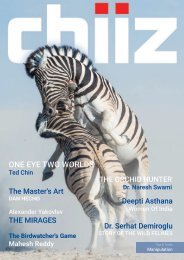Chiiz Volume 11 : Macro Photography
Macro is the genre of photography, which when perfectly captured, can take you to a different world. Be it flowers, birds, insects or any such regular subject present in our surrounding, appears completely different in the zoom lens. When it comes to macro, it requires both skills and patience. This volume is obliged to deliver you with fascinating content. The work of Nicky Bay will leave you in amusement. The beauty pf underwater world of wonderfully captured by Rudo Hvizdos. Exit Hamster will take you on a trip to Oktoberfest through his pictures. Michael Doe’s Project Maratus will introduce you with the prettiest spiders in the world. Pictures by Abd Al-rhman Nafez Hammad are simply a work of excellence. Huub De Waard provides you with the tips to capture Macro Life. The pictures of fine art nude photography, the Muses, will leave you in awe and admiration by its marvelous photography. Find this lot more amazing content in the issue.
Macro is the genre of photography, which when perfectly captured, can take you to a different world. Be it flowers, birds, insects or any such regular subject present in our surrounding, appears completely different in the zoom lens.
When it comes to macro, it requires both skills and patience. This volume is obliged to deliver you with fascinating content. The work of Nicky Bay will leave you in amusement. The beauty pf underwater world of wonderfully captured by Rudo Hvizdos. Exit Hamster will take you on a trip to Oktoberfest through his pictures. Michael Doe’s Project Maratus will introduce you with the prettiest spiders in the world. Pictures by Abd Al-rhman Nafez Hammad are simply a work of excellence. Huub De Waard provides you with the tips to capture Macro Life. The pictures of fine art nude photography, the Muses, will leave you in awe and admiration by its marvelous photography. Find this lot more amazing content in the issue.
You also want an ePaper? Increase the reach of your titles
YUMPU automatically turns print PDFs into web optimized ePapers that Google loves.
are handled. They cut the leaves of plants and use the cut leaf<br />
fragments to form nest cells. They nest in soft, rotted wood or<br />
in the stems of large, pithy plants, such as roses.[From Leaf<br />
cutter Bees – Quick Facts]<br />
One leaf cutter bee had made its home inside a small crevice,<br />
in an old rusted gate of an empty site near my house. It was<br />
constantly flying to and from its new found home, each time<br />
returning with a small piece of something that looked like a<br />
fragment of a leaf. Curious about what it was up to, I sat there<br />
observing it for a while, over one of the weekends and did a<br />
bit of reading on them as well.<br />
The crevice was more like an entrance to, what I felt, was a<br />
long tunnel inside the frame of the gate. Before flying out to<br />
fetch a leaf, the bee, very diligently, would clear the place of<br />
small stones, sand and other debris. Then, it would fly out,<br />
returning after a while, with a small piece of a leaf.<br />
It would enter its home with the leaf and get into the tunnel<br />
that it had cleared just before leaving. Since it was holding<br />
on to the leaf with its mandibles, it seemed that it wasn’t very<br />
easy for the bee to turn the leaf around to align it properly<br />
with the entrance to its tunnel home. So, for the initial few<br />
times, it used to fly out of the crevice and fly back in at the<br />
right angle to be able enter properly.<br />
Prep Work<br />
Nikon D90 105mm F/13 1/160s ISO500<br />
It flies out only to come back in, at an appropriate angle.<br />
Slowly, it seemed to have learnt and thereafter was getting<br />
inside very smoothly, with one flight, straight in.<br />
This bee wasn’t really going too far to look for its leaf<br />
requirements. It had picked a tree close by, to cut out the<br />
pieces of leaf from. It was very skillfully cutting out the leaf<br />
using its mandibles and it seemed to be flying around the tree<br />
looking for the right leaf and upon finding one, was making a<br />
very precise cut each time.<br />
An interesting fact about the bee’s leaf cutting exercise is that<br />
they cut the leaves with their scissor-like mandibles, making<br />
smooth, circular or oval cuts from the edges of leaves that are<br />
about 1/2" in diameter. According to The Xerces Society, it only<br />
takes two or three seconds for the female to cut a piece of leaf.<br />
Just before she finishes cutting it, the female starts to beat her<br />
wings, so she is already flying by the time the leaf fragment is<br />
severed. The cut out designer leaves, thus remain, on the tree<br />
but don’t in any way harm it.(Source: Our Native Bees)<br />
Also, the pieces of the leaf that are carried into the bee’s home<br />
are used to embellish its nest cells and also to separate the<br />
individual cells. These cells would then contain one egg each,<br />
along with a little bit of nectar and pollen to provide for the<br />
larvae that would hatch out of the egg. The females of these<br />
bees are the ones that do all the work.<br />
It takes an average of 15 leaf pieces or flower petals to line one<br />
brood cell, and a total of 20 to 30 trips may be required to<br />
gather the necessary pollen and nectar to provision just one<br />
cell. Under favorable conditions a female bee may finish an<br />
average of 30 cells in her lifetime. [Source: Our Native Bees]<br />
Really hard working mothers these leaf cutter bees are<br />
indeed!<br />
Santhosh Krishnamoorthy<br />
Santhosh is a passionate naturalist and an award winning nature<br />
photographer. He likes to observe and document the interesting aspects<br />
of nature and its inhabitants using photography as a medium. He runs<br />
Birdwing Travel & <strong>Photography</strong> where he mentors budding and amateur<br />
nature photographers. He also posts as @santhosh.kris on Instagram<br />
and blogs at framesofnature.com<br />
Nesting Leaves<br />
Nikon D90 105mm F/10 1/160s ISO400












